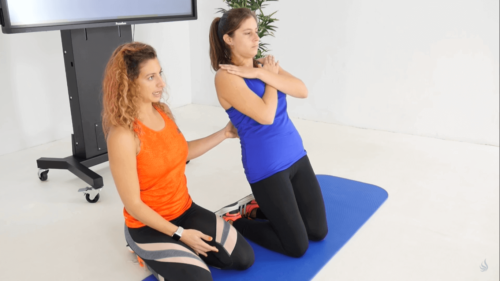Exercises to Treat Pes Anserine Bursitis

We’re all susceptible to suffering from pes anserine bursitis. This is a common pathology that causes knee pain in those who suffer from it. In this article, we’ll explain exactly what it is and share some exercises to improve this pathology.
What’s pes anserine bursitis?
The terms that are normally used in medicine, even if they sound complicated, always have their explanations. You just have to take some physiology aspects into account to deduce their meanings.
One of the words that concern us is “bursitis”, which means inflammation of one or more bursae. It’s a problem that affects both athletes and non-athletes. In addition, it must be properly treated to ensure it doesn’t prolong over time.
You need to remember that tendons are the structures that connect the muscles with the bones. When the former contract, they transmit the forces to make the latter move. By transmitting forces they aren’t prepared for, not doing it in ergonomic postures, or doing it with great frequency, the tendon suffers and becomes inflamed, which is known as tendinitis.
Typically, each tendon deals with a single muscle. However, imagine that a single tendon has to deal with three muscles at the same time. Well, this is when the second word comes into play: pes anserine.
The word “per anserine” refers to the area also known as goose foot, where the conjoined tendons sartorius, gracilis, and semitendinosus insert into the anteromedial proximal tibia. These three muscles go to the same tendon, which is on the inside of the knee, and which inserts into the tibia.
Now you’ll be able to understand a little more about anatomy. Thus, it might seem logical why a tendon that has to exert its function for three muscles at the same time is more susceptible to pathologies. As it’s in the knee, all the movements this structure performs on a daily basis increase the possibility of injury.
Exercises for pes anserine bursitis
At the beginning, like any bursitis, it must be treated conservatively. This means hot and cold therapy and rest, accompanied by anti-inflammatory medications if you need them.
Once the swelling reduces and you’ve ruled out surgery, which is only required in the most serious cases, you can proceed to rehabilitation exercises. As with any other bursitis, our best ally against pes anserine bursitis are eccentric exercises.
These exercises have been the subject of frequent physical therapy study in recent years. This is because their effectiveness for a variety of problems is being demonstrated. They’re called eccentric because we stretch a muscle while we contract it. Thus, it’s contracting eccentrically.
To understand it better, we can say that the muscle makes force but weight wins over it. Imagine that you’re holding a dumbbell in your hand. When you bring the dumbbell closer to your arm, you’re beating the force and doing a concentric exercise.
As you straighten your arm again, your bicep continues to exert force but less force than it needs to overcome it and flex your elbow again. This is an eccentric exercise.
Eccentrics and stretching
In the case of pes anserine bursitis, you must do the following:
- Squats are a good example of an eccentric exercise. They’re a good idea because the hamstrings work, including the semitendinosus muscle.

- Here’s another more aggressive but effective exercise. While you’re kneeling on the floor, place your feet under a stable structure or ask another person to hold your feet so they don’t get up. Next, slowly drop your weight forward, controlling the movement but letting gravity do its job, until you can’t hold the position anymore. When this happens, drop down and place your palms on the ground. Get back on your knees and repeat.

- For the sartorius muscle, sit on a chair, bed, or stretcher that allows you to dangle your legs without touching the ground. Tie a resistance band in the shape of a circle and put one part around the heel of your good leg and the other part around the knee of the leg affected by tendinitis. The exercise consists of slowly elevating and lowering the inside of the foot of the affected leg by the inside of the good leg, from the ankle to the knee. The resistance band will stretch when you elevate and relax when you lower it. When you elevate your leg, you do a concentric exercise. When you lower your leg, you do an eccentric exercise.
- Finally, you should also stretch the affected muscles and the thigh muscles in general.

In short, you should note that eccentric exercises are quite demanding. They work the muscles intensively and stimulate tendon insertions. Therefore, you should take basic precautions, such as warming up with gentle exercises before doing them and stretching afterwards.
We’re all susceptible to suffering from pes anserine bursitis. This is a common pathology that causes knee pain in those who suffer from it. In this article, we’ll explain exactly what it is and share some exercises to improve this pathology.
What’s pes anserine bursitis?
The terms that are normally used in medicine, even if they sound complicated, always have their explanations. You just have to take some physiology aspects into account to deduce their meanings.
One of the words that concern us is “bursitis”, which means inflammation of one or more bursae. It’s a problem that affects both athletes and non-athletes. In addition, it must be properly treated to ensure it doesn’t prolong over time.
You need to remember that tendons are the structures that connect the muscles with the bones. When the former contract, they transmit the forces to make the latter move. By transmitting forces they aren’t prepared for, not doing it in ergonomic postures, or doing it with great frequency, the tendon suffers and becomes inflamed, which is known as tendinitis.
Typically, each tendon deals with a single muscle. However, imagine that a single tendon has to deal with three muscles at the same time. Well, this is when the second word comes into play: pes anserine.
The word “per anserine” refers to the area also known as goose foot, where the conjoined tendons sartorius, gracilis, and semitendinosus insert into the anteromedial proximal tibia. These three muscles go to the same tendon, which is on the inside of the knee, and which inserts into the tibia.
Now you’ll be able to understand a little more about anatomy. Thus, it might seem logical why a tendon that has to exert its function for three muscles at the same time is more susceptible to pathologies. As it’s in the knee, all the movements this structure performs on a daily basis increase the possibility of injury.
Exercises for pes anserine bursitis
At the beginning, like any bursitis, it must be treated conservatively. This means hot and cold therapy and rest, accompanied by anti-inflammatory medications if you need them.
Once the swelling reduces and you’ve ruled out surgery, which is only required in the most serious cases, you can proceed to rehabilitation exercises. As with any other bursitis, our best ally against pes anserine bursitis are eccentric exercises.
These exercises have been the subject of frequent physical therapy study in recent years. This is because their effectiveness for a variety of problems is being demonstrated. They’re called eccentric because we stretch a muscle while we contract it. Thus, it’s contracting eccentrically.
To understand it better, we can say that the muscle makes force but weight wins over it. Imagine that you’re holding a dumbbell in your hand. When you bring the dumbbell closer to your arm, you’re beating the force and doing a concentric exercise.
As you straighten your arm again, your bicep continues to exert force but less force than it needs to overcome it and flex your elbow again. This is an eccentric exercise.
Eccentrics and stretching
In the case of pes anserine bursitis, you must do the following:
- Squats are a good example of an eccentric exercise. They’re a good idea because the hamstrings work, including the semitendinosus muscle.

- Here’s another more aggressive but effective exercise. While you’re kneeling on the floor, place your feet under a stable structure or ask another person to hold your feet so they don’t get up. Next, slowly drop your weight forward, controlling the movement but letting gravity do its job, until you can’t hold the position anymore. When this happens, drop down and place your palms on the ground. Get back on your knees and repeat.

- For the sartorius muscle, sit on a chair, bed, or stretcher that allows you to dangle your legs without touching the ground. Tie a resistance band in the shape of a circle and put one part around the heel of your good leg and the other part around the knee of the leg affected by tendinitis. The exercise consists of slowly elevating and lowering the inside of the foot of the affected leg by the inside of the good leg, from the ankle to the knee. The resistance band will stretch when you elevate and relax when you lower it. When you elevate your leg, you do a concentric exercise. When you lower your leg, you do an eccentric exercise.
- Finally, you should also stretch the affected muscles and the thigh muscles in general.

In short, you should note that eccentric exercises are quite demanding. They work the muscles intensively and stimulate tendon insertions. Therefore, you should take basic precautions, such as warming up with gentle exercises before doing them and stretching afterwards.
All cited sources were thoroughly reviewed by our team to ensure their quality, reliability, currency, and validity. The bibliography of this article was considered reliable and of academic or scientific accuracy.
- Efficacy of eccentric exercises with therapeutic ultrasound for the management tendo achilles tendinitis among elite. Karthikeyan, Narayanan B, Dass SP, Dwaraknath, Pradnya. International Journal of Adapted Physical Education & Yoga, Vol. 2, No. 2 (2017)
- Gutiérrez GJ, Fernández FM, Sandoval HS. Tendinitis y bursitis de la pata de ganso. Ortho-tips 2014; 10 (3)
- Eficacia y seguridad de la infiltración con metilprednisolona en pacientes con síndrome anserino: ensayo clínico aleatorizado. David V, Jorge A, Valerio R, López D, Ángel G, Mario A. Reumatología Clínica. Volume 8, Issue 2, March–April 2012, Pages 63-67
This text is provided for informational purposes only and does not replace consultation with a professional. If in doubt, consult your specialist.








